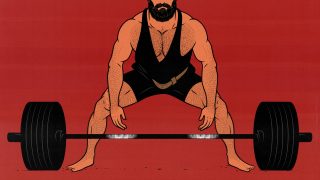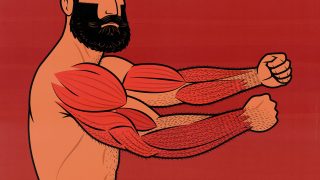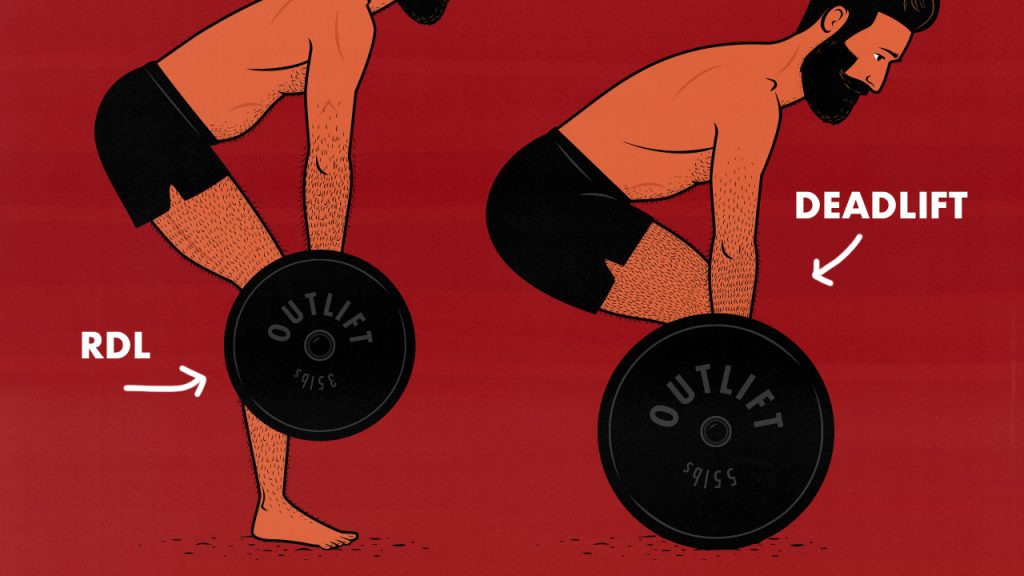
RDL vs Deadlift: Which is Better for Building Muscle?
Romanian deadlifts (RDLs) and conventional deadlifts are more similar than they are different. They’re both deadlifts. They both work the same muscles, just to different degrees:
- RDLs are lighter, work your hamstrings harder, and won’t tax your spine quite as much, making them less fatiguing. They’re popular with bodybuilders. Use them if you want to emphasize your hamstrings.
- Deadlifts are heavier, work your butt and back harder, and strengthen your spine, making them one of the best overall exercises for gaining muscle and strength. They’re popular with powerlifters. Use them if you to gain overall size and strength.
That’s the answer, but we can delve a little deeper into the specifics.
What’s the Difference?
Both RDLs and deadlifts have you standing in a narrow stance, gripping the barbell in your hands, and moving at the hips while maintaining a strong posture. They’re very similar.
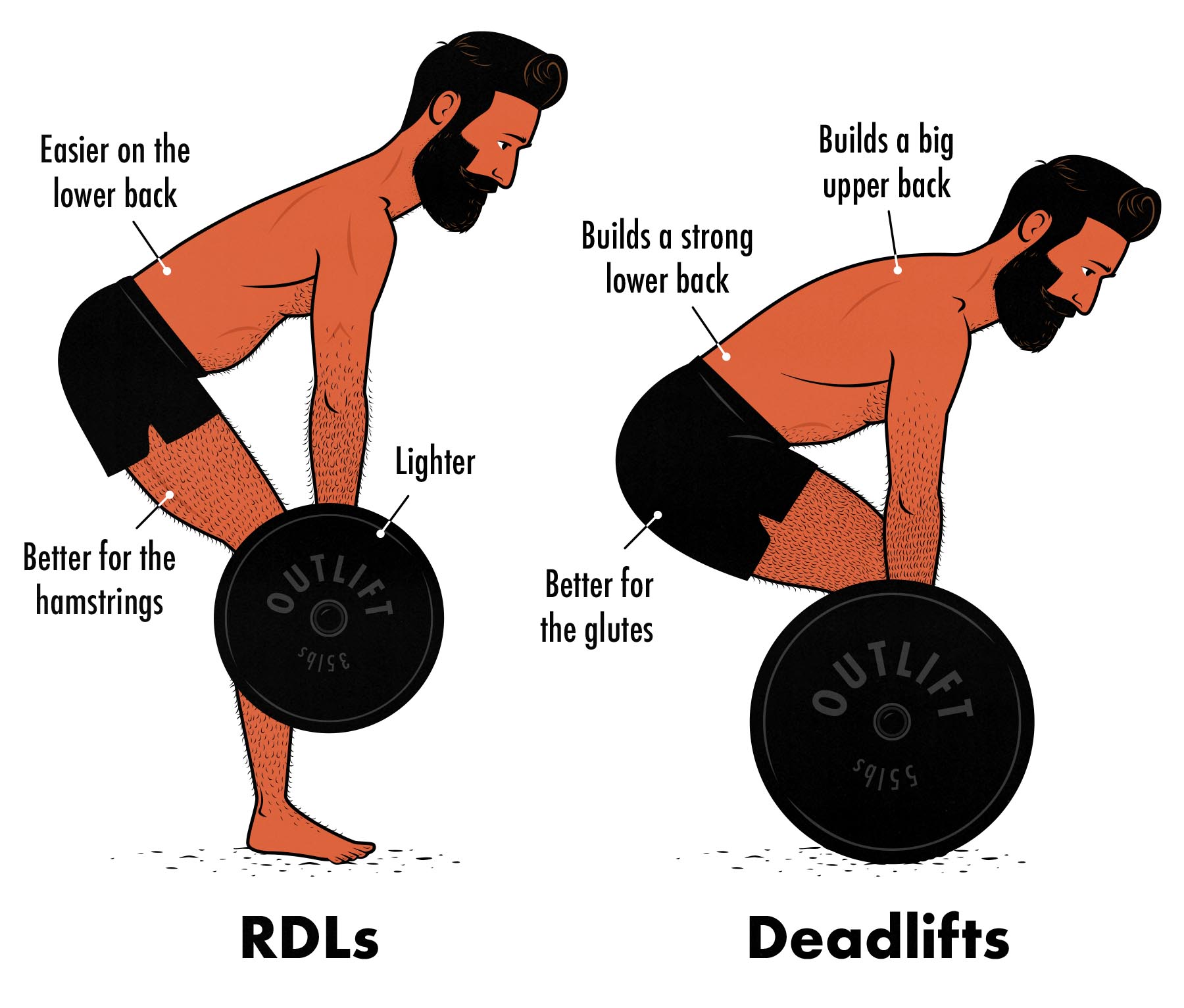
Romanian Deadlifts:
- You start in the top position and lower the weight down until you stretch out your hamstrings. This makes the RDL easier for beginners. You can lower the weight as deep as you can, but you don’t need to make it all the way to the floor. (More likely, the weight will just barely pass your knees.)
- You keep your knees stiff. It’s okay if you bend your knees a little bit, but you should keep them mostly straight. Your hamstrings cross the knee joint, so when you keep your knees stiff, it keeps the tension on your hamstrings. That’s why RDLs work your hamstrings harder.
- You send your butt backwards. You can imagine trying to tap the wall behind you with your glutes. This does a great job of loading your glutes and hamstrings, but it also worsens your leverage, preventing you from lifting as much weight.
- You lower the weight down slowly. You can stimulate quite a lot of muscle growth by controlling the weight on the way down. RDLs take advantage of this. There’s more emphasis placed on the lowering portion of the lift.
- RDLs aren’t as fatiguing. The weight is lighter, and you spend less time with your torso bent over, so your spine and spinal erectors don’t need to work as hard. This frees up more energy for other exercises.
Conventional Deadlifts:
- You start in the bottom position, with the weight “dead” on the floor. Not everyone has the mobility to get into position while keeping their backs straight. That can make conventional deadlifts tough for beginners to learn. If you can’t get into the starting position, better to start with RDLs.
- Bending your knees allows you to use a much larger range of motion. If you let your knees bend, your hamstrings won’t limit your range of motion. You’ll be able to get much deeper. This can nearly double your range of motion, keeping your butt and back under load for much longer.
- You can use heavier weights. Bending your knees means you can keep your hips closer to the bar, giving you better leverage. This means you get to hold more weight in your hands, putting your back and butt under greater load.
- Powerlifters drop the weight. They lift the weight up and then drop it back to the floor. They do this to minimize muscle damage, allowing them to train heavier more often. but it comes at the cost of stimulating less muscle growth. If you’re training for muscle growth, you should lower the weight down under control.
- Deadlifts stimulate more muscle growth. Squats and deadlifts stimulate more total muscle growth than any other exercise. If you want a minimalist routine, they should both be at the heart of it.
How to Do RDLs
RDLs are one of the easiest deadlift variations to learn, especially if you can start with the barbell on a half rack. Here’s Marco teaching the exercise:
You can use dumbbells instead of a barbell. If the weight keeps trying to slip out of your grip, the easiest solution is to get lifting grips. Your grip will get plenty strong from all the other exercises you do. The obvious exception is if you’re a powerlifter. Powerlifters can’t use straps. (Strongmen can.)
How to Do Deadlifts
Deadlifts are a fairly intuitive exercise. You brace, and then you lift the weight up. It’s a movement you’ve already done thousands of times. If you can’t keep your back straight while getting into the starting position, though, then you might want to start with RDLs instead.
Muscles Worked
Both RDLs and deadlifts work the same muscles: your hips, hamstrings, and entire back, including your spinal erectors. The difference is that RDLs emphasize your hamstrings, whereas deadlifts emphasize your butt and back.
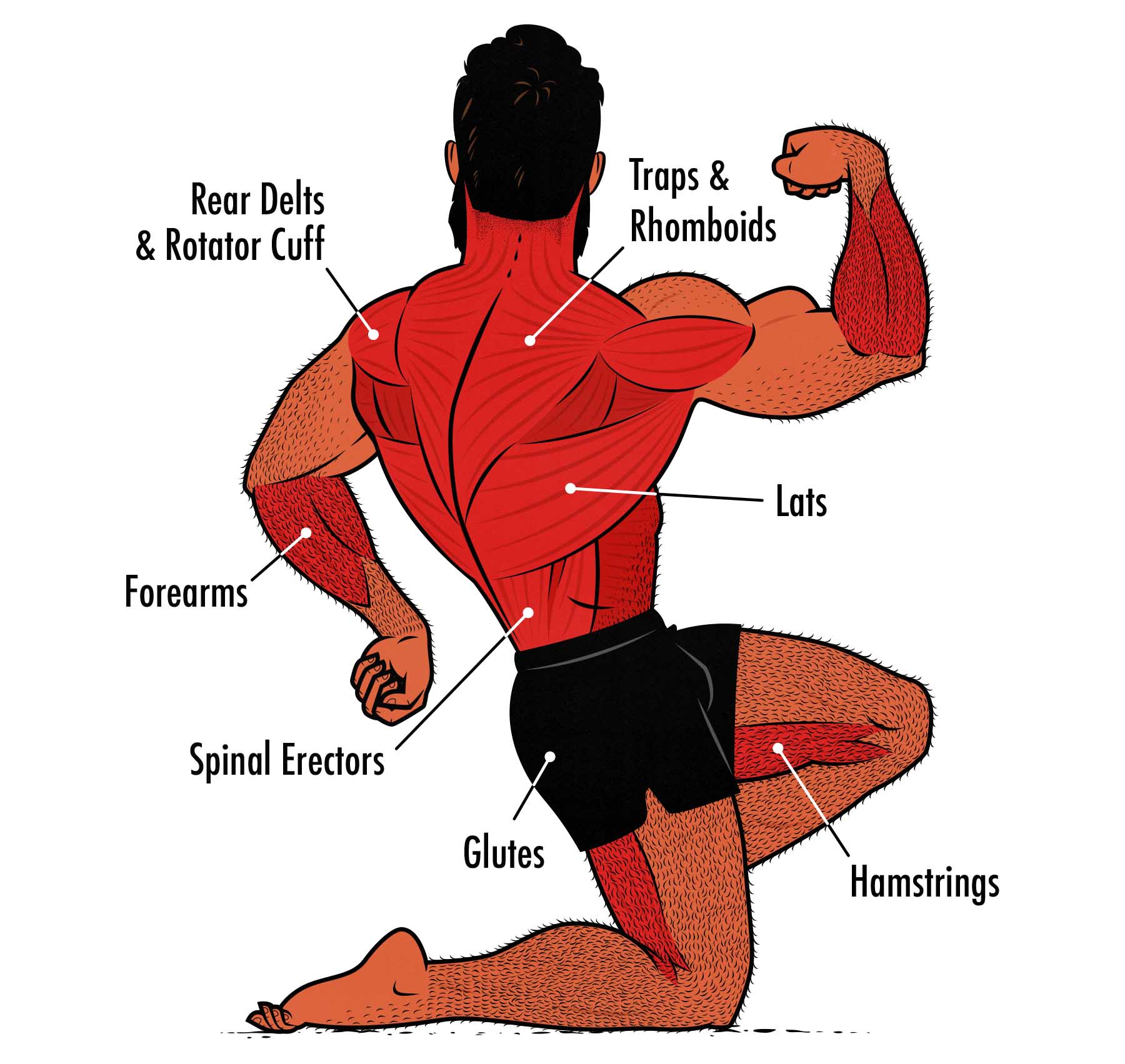
Deadlifts are More Fatiguing
The main reason people choose RDLs over deadlifts is that they have a better stimulus-to-fatigue ratio (SFR). This is an idea popularized by Dr. Mike Israetel. The idea is that you should focus on exercises that are less fatiguing so that you have more energy to stimulate more muscle growth. I’ve got a full article on SFR here (including its problems).
Most people have too little physical stimulation in their lives, not too much. If you’re working out 2–4 times per week, and if your job is fairly sedentary, then you don’t need to worry very much about systemic fatigue. Generally, the more fatigue you accumulate with your workout, the more muscle you’ll build, the more strength you’ll gain, and the healthier you’ll get (provided you eat enough afterwards).
It’s more the elite athletes, bodybuilders, and powerlifters that need to worry about fatigue. They’re training every day, often for several hours. They’re also handling much heavier weights.
On the other hand, deadlifts can be pretty tiring for anyone at any experience level. As a beginner, it’s easy to overwork your spinal erectors. And you use your spinal erectors to sit and stand, so when they’re tired, it makes you feel like you need to lie down. The fatigue might be improving your health and results while harming your ability to focus on other areas of your life. That isn’t always a worthwhile trade.
As your spinal erectors get stronger, your muscles stop getting as sore, and you develop such a surplus of postural strength that it stops being an issue. But your deadlifts also get much heavier. You go from deadlifting 135 pounds to 225, then 315, and soon you’re doing sets with 405. Those sets can start to feel pretty daunting.
RDLs make all of this much easier. They’re still pretty heavy, and they’re still a big compound exercise, but you mainly feel them in your hamstrings, and that really isn’t so bad. Plus, it’s nice to build bigger hamstrings.
Which is Better?
Powerlifters and strongmen need to get stronger at deadlifts. Everyone else can pick the variation they prefer (or use a mix). The important thing is to have a lift that works the postural muscles in your back, your hips, and your hamstrings. Both deadlifts and RDLs are great for that. I do both.
As you get bigger and stronger, regular deadlifts can become daunting. The weight starts to feel oppressively heavy. You might not want to deal with the fatigue of deadlifting 400–500 pounds over and over again. It’s okay to take a break from them. RDLs are great for that.
Even as a beginner, you might find that your spinal erectors get sorer than any of your other muscles. In that case, you can ease into building a stronger back with RDLs. You’ll get some extra hamstring stimulation and quite a bit less fatigue. And your spinal erectors will still grow.
You might also have a back injury that flares up whenever you’re too aggressive with your deadlifts. Spending some time doing lighter sets of Romanian deadlifts might give your back a break while still developing some strength there.



